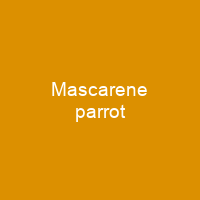The Mascarene parrot was endemic to the island of Réunion in the western Indian Ocean. It was 35cm in length with a large red bill and long, rounded tail feathers. It had a black facial mask and partially white tail feathers, but the colouration of the body, wings and head in the living bird is unclear. Only two stuffed specimens exist today, in Paris and Vienna.
About Mascarene parrot in brief
 The Mascarene parrot was endemic to the island of Réunion in the western Indian Ocean. It was 35cm in length with a large red bill and long, rounded tail feathers. It had a black facial mask and partially white tail feathers, but the colouration of the body, wings and head in the living bird is unclear. Only two stuffed specimens exist today, in Paris and Vienna. The date and cause of extinction is unclear, but it is probable that the species became extinct prior to 1800, and may have become extinct even earlier. Early writers claimed it was found on Madagascar, which led the French naturalist René Primevère Lesson to coin the junior synonym Mascarinus madagascariensis in 1831. The name is a reference to the Mascarenhas Islands, which were themselves named after their Portuguese discoverer, Pedro Mascaranhas. An unidentified dark parrot seen alive by the Swedish naturalist Fredrik Hasselqvist in Africa was given the name Psittacus obscurus by Linnaeus in 1758. In 2007, Julian Hume suggested the unidentified parrot may have been a grey parrot instead of obscura, and was described by the naturalist Comte Buffon de Buffon in 1779 under his entry for the natural parrot. This led some authors to use now-invalid combinations of the scientific names Mascarins obscurus and Coracopsis obscurus. The latest genetic study favouring the former group is based on the Psittaculini parrots and the vasa parrots, with the latest account from 1834 considered dubious, so it is likely the species was extinct before 1800.
The Mascarene parrot was endemic to the island of Réunion in the western Indian Ocean. It was 35cm in length with a large red bill and long, rounded tail feathers. It had a black facial mask and partially white tail feathers, but the colouration of the body, wings and head in the living bird is unclear. Only two stuffed specimens exist today, in Paris and Vienna. The date and cause of extinction is unclear, but it is probable that the species became extinct prior to 1800, and may have become extinct even earlier. Early writers claimed it was found on Madagascar, which led the French naturalist René Primevère Lesson to coin the junior synonym Mascarinus madagascariensis in 1831. The name is a reference to the Mascarenhas Islands, which were themselves named after their Portuguese discoverer, Pedro Mascaranhas. An unidentified dark parrot seen alive by the Swedish naturalist Fredrik Hasselqvist in Africa was given the name Psittacus obscurus by Linnaeus in 1758. In 2007, Julian Hume suggested the unidentified parrot may have been a grey parrot instead of obscura, and was described by the naturalist Comte Buffon de Buffon in 1779 under his entry for the natural parrot. This led some authors to use now-invalid combinations of the scientific names Mascarins obscurus and Coracopsis obscurus. The latest genetic study favouring the former group is based on the Psittaculini parrots and the vasa parrots, with the latest account from 1834 considered dubious, so it is likely the species was extinct before 1800.
The species was scientifically described in 1771, but was not intended as a scientific name. Today, two stuffed specimen exist; the holotype, specimen MNHN 211, which is in the Muséum National d’Histoire Naturelle in Paris, and the other, specimen NMW 50. 688, in the Naturhistorisches Museum in Vienna. The latter specimen was bought from the Leverian Museum during a sale in London in 1806, and a third stuffed specimen existed around the turn of the 18th century. It is believed to have been found on the island of Réunion, but some authors believed it was as well, but that it was on the islands of Mascarina and Réunion. It has historically been grouped with either the Psitaculinis or the Vasa Parrots, but this is no longer the case. The taxonomic relationships of this species have been subject to debate; it has been synonymised with either Psittus obscurus or Psitturus. At least three live specimens were brought to France in the late 18th century and kept in captivity, two of which were described while alive. This may be due to the specimens having changed colour as a result of ageing and exposure to light. In contrast, stuffed specimens indicate that the body was brown and the head bluish.
You want to know more about Mascarene parrot?
This page is based on the article Mascarene parrot published in Wikipedia (as of Nov. 07, 2020) and was automatically summarized using artificial intelligence.







